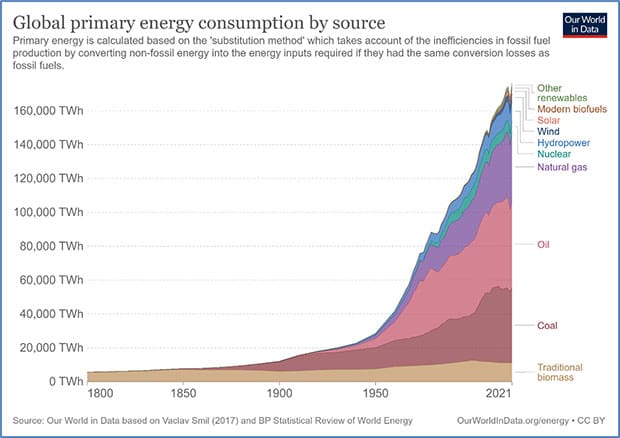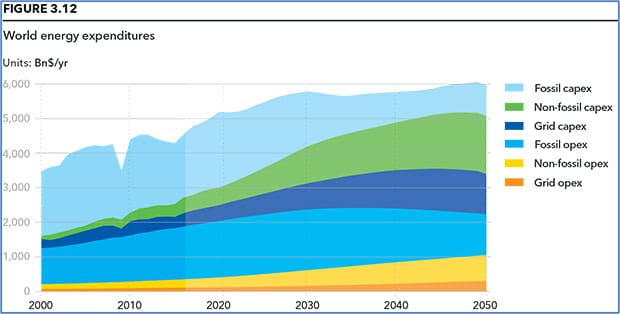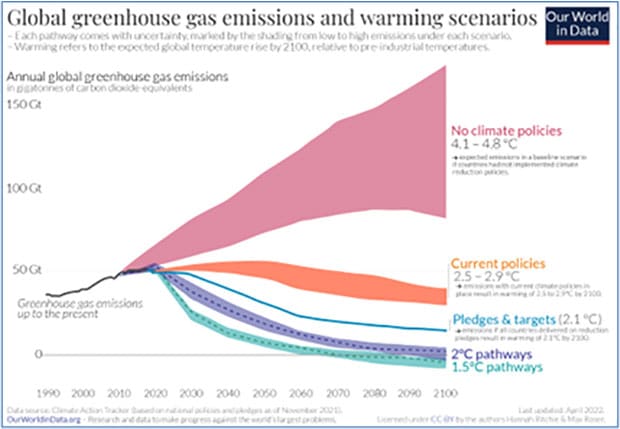Ignoring the crucial role of fossil fuels in any energy transition plan risks economic collapse

For interview requests, click here
The world is undergoing a major shift from fossil fuels to renewable energy sources to combat climate change. This transition has become a common topic of discussion, and global events like COP27 in Sharm El Sheikh, Egypt, highlight its far-reaching effects on economies, business risks, livelihoods, and geopolitics.
Numerous strategies are being promoted with great fanfare to achieve the energy transition, but most have serious flaws and are unlikely to succeed. Many advocates of a rapid transition tend to overlook the crucial role fossil fuels play in maintaining energy security during the shift and providing funding for the transition itself.
Mankind benefited from previous energy transitions from wood to coal around 1850 and then to fossil fuels around 1950. After every transition, energy costs decreased, convenience increased, and adverse environmental impacts decreased. Our current energy transition to renewables will be dramatically more significant in scale and more challenging to complete than previous transitions because of the following differences:
World population
The world population is much higher, as shown below. Since 1800, the world’s population has increased by 800 percent from approximately one billion to eight billion.
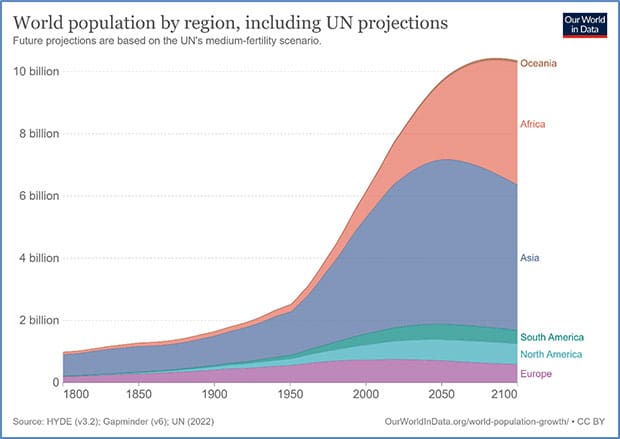
Source: World Population Growth
All these people consume fossil fuel energy and derive more value from additional energy. The complex infrastructure that delivers energy seamlessly to them will change significantly at an enormous cost during the coming energy transition.
World energy consumption
As shown below, world energy consumption is dramatically higher because per capita consumption has increased even faster than population. Since 1800, the world’s energy consumption has increased 16 times from less than 10,000 TWh to over 160,000 TWh.
Per capita energy consumption increases as living standards improve. In the 20th century and early 21st century, billions of people emerged from poverty. This exciting trend accounts for the dramatic increase in energy consumption. This trend also increases the enormity of the energy transition.
World energy infrastructure
As shown below, the investments required to build and operate the world’s energy infrastructure are vast. Introducing more renewable energy generation, distribution and consumption infrastructure into the mix increases total expenditures. Currently, the investments are running in the $ hundreds of billions annually. Before 2030, the investment required to avoid energy shortages and insecurity will be about $1 trillion annually.
These trillions of dollars in required investments to complete the energy transition will undoubtedly increase energy costs for individual and business consumers for many years.
Resistance to change
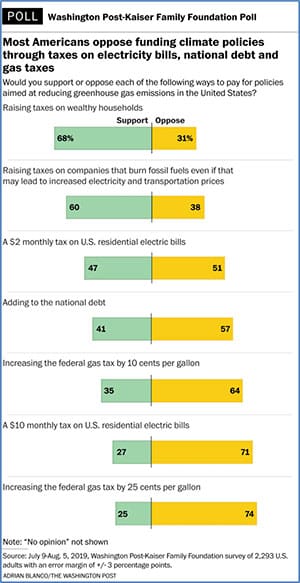
Source: Washington Post Poll Shows Most People Unwilling to Pay $2 Per Month Tax to Fight Climate Change
The change this transition will impose on individuals, businesses, and governments is significant because no one likes change. Individuals and companies eagerly adopted previous energy transitions because they offered immediate cost and convenience benefits. Neither of these benefits is apparent in the coming transition.
An excellent way to illustrate the resistance to change this time is through attitudes about spending money. The chart on the left shows how little money people are willing to pay for the energy transition. Only half the citizens are willing to accept a mere $2 increase in their monthly residential electric bill.
None of the acceptable proposals in this survey will work even though they are popular. Taxing the rich won’t raise enough money and tends to undermine investment that leads to economic growth.
The available research says that companies only remit taxes. Company income taxes are paid indirectly by shareholders through lower dividends, employees through lower wages and customers through higher prices.
This poll and similar research suggest that the energy transition will be gradual even though that pace will increase the damage climate change inflicts on the planet.
Given the enormity of the energy transition and the resistance to paying for it, what are the ineffective and practical paths forward?
Aggressive energy transition approach
The aggressive transition approach that the Liberal government has laid out for Canada and European countries have laid out for themselves should scare everyone for these reasons:
- It’s expensive for taxpayers who provide the subsidies and tax credits being doled out liberally.
- The anti-energy policies of these governments have led to under-investment in energy development, which will lead to higher energy prices and the risk of energy insecurity.
- It’s risky because some required technologies are just emerging from the lab or have never been scaled up as needed.
- The proposed speed may be faster than individuals, and businesses can be expected to change.
- It’s expensive for energy consumers as some infrastructure is being retired before its end of life.
The most significant benefit of pursuing the aggressive timeline is the leaders of these governments preening on the international stage. Is that worth it?
World energy transition reality
Will the go-fast approach being promoted so heavily turn out to be faster than a more measured pace? The following realities, illustrated on the chart below, suggest not:
- Many countries are underperforming against the public climate change commitments they’ve made.
- Even with a less ambitious commitment, China is still underperforming and is building many coal-fired electricity-generating stations.
- Many countries have made no public commitments.
- The plans of the countries that have made public commitments, plus the assumption that the remaining countries may make similar commitments, do not reach the goal of limiting the temperature increase to 1.5 – 2.0 degrees.
- The impact of the Russian invasion of Ukraine is causing some countries to de-commit from their previous public commitment due to the risk of energy insecurity.
The chart projects that even if countries meet the GHG emission reduction targets for 2030 and 2050 that they have announced, the result is insufficient to address climate change.
Realistic energy transition approach
A more realistic energy transition approach is more likely to be ultimately successful. It won’t meet the GHG emission reduction targets agreed on for 2030 and 2050. A candid assessment suggests the aggressive transition approach won’t either.
A more realistic energy transition approach consists of the following elements:
- Introduce a carbon tax and use the revenue to reduce public sector debt or pay for some of the transition’s incremental costs.
- Increase automobile driving costs through higher gasoline taxes and registration fees. The increased cost will be the incentive to drive less and buy an EV or hybrid.
- Strengthen building codes toward energy efficiency and sustainability.
- Build out public transportation where ridership warrants it.
- Don’t build any more coal-fired electricity generation stations.
- Build renewable electricity generation and distribution capacity. The associated increased cost will be an incentive to conserve energy.
- Revise high GHG emission manufacturing processes.
- Reduce methane emissions from various sources, including oil & natural gas production.
- Increase the population density of cities as these are developed and redeveloped.
- Renovate buildings to reduce their GHG emission footprint.
A more realistic energy transition approach will reduce the transition cost and provide a reasonable window for individuals and businesses to make appropriate changes and investments.
Yogi Schulz has over 40 years of information technology experience in various industries. Yogi works extensively in the petroleum industry. He manages projects that arise from changes in business requirements, the need to leverage technology opportunities, and mergers. His specialties include IT strategy, web strategy and project management.
Explore more on Energy security, Energy transition, Energy poverty
The opinions expressed by our columnists and contributors are theirs alone and do not inherently or expressly reflect the views of our publication.
Troy Media
Troy Media is an editorial content provider to media outlets and its own hosted community news outlets across Canada.


